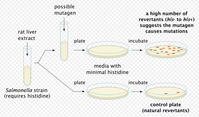








The Ames test is a widely employed method that uses bacteria to test whether a given chemical can cause mutations in the DNA of the test organism. More formally, it is a biological assay to assess the mutagenic potential of chemical compounds.A positive test indicates that the chemical is mutagenic and therefore may act as a carcinogen, because cancer is often linked to mutation. The test serves as a quick and convenient assay to estimate the carcinogenic potential of a compound because standard carcinogen assays on mice and rats are time-consuming (taking two to three years to complete) and expensive. However, false-positives and false-negatives are known.
Procedure
The Ames test uses several strains of the bacterium Salmonella typhimurium that carry mutations in genes involved in histidine synthesis. These strains are auxotrophic mutants, i.e. they require histidine for growth, but cannot produce it. The method tests the capability of the tested substance in creating mutations that result in a return to a "prototrophic" state, so that the cells can grow on a histidine-free medium.
The tester strains are specially constructed to detect either frameshift (e.g. strains TA-1537 and TA-1538) or point (e.g. strain TA-1531) mutations in the genes required to synthesize histidine, so that mutagens acting via different mechanisms may be identified. Some compounds are quite specific, causing reversions in just one or two strains.The tester strains also carry mutations in the genes responsible for lipopolysaccharide synthesis, making the cell wall of the bacteria more permeable,and in the excision repair system to make the test more sensitive.Rat liver extract is optionally added to simulate the effect of metabolism, as some compounds, like benzo pyrene, are not mutagenic themselves but their metabolic products are.
The bacteria are spread on an agar plate with a small amount of histidine. This small amount of histidine in the growth medium allows the bacteria to grow for an initial time and have the opportunity to mutate. When the histidine is depleted only bacteria that have mutated to gain the ability to produce its own histidine will survive. The plate is incubated for 48 hours. The mutagenicity of a substance is proportional to the number of colonies observed.